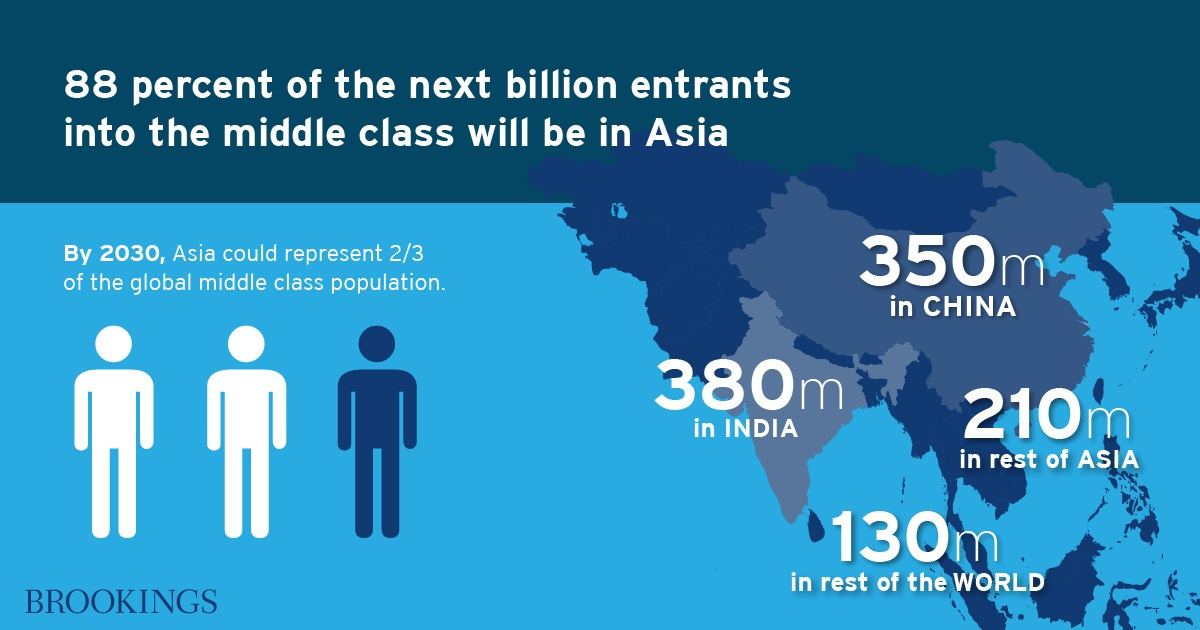3 Things: Rising Middle Class Data, PCP SaaS Marketplace, Furniture Arbitrage
Happy Sunday and a very warm welcome to all the new subscribers! I’m thrilled and honored to have you as readers and truly appreciate your thoughts and feedback 🙏. Each edition of 3 Things will contain a dive into 3 rabbit holes I’ve found myself going down recently and associated business opportunities. Subscribe to get each week’s edition straight to your inbox and if you enjoy it, please share (I suck at self-promotion so can use your help)! This past week I’ve been thinking a lot about:
Rising Middle Class Data
PCP SaaS Marketplace
Furniture Arbitrage
1. Rising Middle Class Data
The global middle class has been rising at a rapid clip since 2000 and continues to grow at an astounding pace, led primarily by India and China. By 2030, it is estimated that the global middle class will reach nearly 5 billion with China and India representing around 2/3 of the entire group. Over 70% of China’s population could fall into this bucket with an annual spending power of $10 trillion. In 2015, the global middle class spend was $35 trillion which was almost entirely done by the US and Europe, and just 15 years later, the Indian and Chinese middle class populations are expected to spent that much alone.
The middle class is already the largest spending group on the planet and as another 700 million people enter this cohort in the next few years, there will be massive shifts in consumption and spending patterns. Everything from diet, consumer packaged goods, energy demands, travel, and more will change. I recently spoke with a company on my podcast (un)sexy that does dairy supply chain and this shift in spending ability is causing an gigantic rise in the demand for milk. Data like this will be important for many industries so there is an opportunity to create a data business collecting information on the spending patterns of the emerging middle class across the world. Aggregate (as real-time as possible) information from a variety of vendors/sources including financial ones, package it up, and sell it to businesses in categories like agriculture, CPG/e-commerce, supply chain, finance and more.
2. PCP SaaS Marketplace
There has been a lot of consolidation in the healthcare world with major health systems and MCOs (Managed Care Organizations) like UnitedHealth Group (the World’s 7th largest company by revenue which owns an absolutely insane number of subsidiaries), the CVS-Aetna merger, Amazon slowly buying up companies like PillPack and now OneMedical. Insurers have been purchasing physician practices and pharmacy benefit managers. At the same time, there has been an unbundling of the hospital as more care shifts to retail clinics, community-based, and virtual and focus shifts to preventative as opposed to solely sick care. The PCP or primary care physician is the first line of defense when it comes to care and a linchpin for preventative medicine. Around 1/3 of all doctors in the US (~200k) are primary care physicians who work across ~140k practices which tend to be small and spread across the country as this is often the only doctor that most people see.
Just like the unbundling of SaaS with startups purchasing dozens of best-in-breed point solutions and the consumerization of enterprise where business users want seamless, modern consumer-like experiences, so many vendors are now trying to sell modern software to PCPs for everything from EMR and billing to scheduling, patient communications, remote monitoring and much more. There are even low-cost hardware devices and apps for smartphones that can check for conditions like vision disorders in children or diabetic retinopathy in adults. Independent primary care and direct primary care/concierge practices tend to not be the most sophisticated buyers so a marketplace with a concierge services component could be a win-win to help practices find solutions that enable them to provide better care and let the physicians focus on patient interactions and vendors could have distribution and easier access to buyers. The model would be to take a cut of each transaction and charge for services provided.
3. Furniture Arbitrage
There are 30 million people who move every year in the United States. That is over 82k families every single day. One of the biggest pains about moving is dealing with furniture. Moving is often a great time to get rid of old stuff, especially large bulky things like furniture, but if you want to sell items, you have to either go to a marketplace like Facebook or Craigslist, or specialized e-comm sites like AptDeco or Remoov. Often you're selling items piecemeal and potentially only getting paid if the item sells in the future. Moving is already a chaotic, time-boxed event so if you can't sell everything by the time you move, you have to either move the bulky items yourself or pay to dispose of them.
Typically when you move, you're either upsizing or downsizing and the furniture that worked in your old place (from both an aesthetic and space-filling perspective) doesn’t work in the new space. The irony is, the person or family who is moving out of that house/apartment/condo or any other one nearby is likely trying to sell all (or a lot) their furniture at the same time you're looking to buy. A company could partner with realtors and stagers, and scrape the MLS/listing sites to know when a home goes on the market. You can then reach out to the sellers to see if they are interested in selling their furniture. On the flip side, you can use realtors to help do photography and inventory of the seller’s items and offer discounted, nice furniture that can be moved in before the buyers get there. It can be hyperlocal sales and moves so a few trucks, labor, and a warehouse for anything that needs temporary storage would be the bulk of what you need once you build up the engine. Additionally, stagers sell their furniture after it’s been used for a while and today there is no easy way to buy from stagers, so that is another source to tap into for getting items in one go to fully furnish a home.
That’s all for today! If you have thoughts, comments, or want to get in touch, find me on Twitter at @ezelby and if you enjoyed this, please subscribe and share with a friend or two!
~ Elaine
New podcast!
From scrap metal to timber, estate planning to freight pooling, the new (un)sexy podcast is a meandering exploration of just how sexy unsexy industries can be.
Join us weekly as we uncover stories of niche and esoteric markets, understanding their history and looking at the future through the eyes of the pioneering entrepreneurs willing to bring technology and exponential improvements to these often overlooked spaces.
Listen now on Spotify, Apple, Google, or wherever you listen to podcasts.





Another banger Elaine! "Furniture Arbitrage" particularly resonated with me. I had a startup in that space called Rumgr (mobile friendly Craigslist). We were based in Las Vegas but saw a constant stream of Los Angeles <-> Las Vegas people moving back and fourth. I always thought it would be a good idea to put 1 warehouse in each city and just let people buy and sell (consignment style) on either side of that corridor as they move. Then use Lugg or Dolly to handle delivery.
The key to growth would be to ingest interstate (or intrastate, ex. Bay Area <-> LA) moving data and launch a new warehouse in the biggest moving corridors.